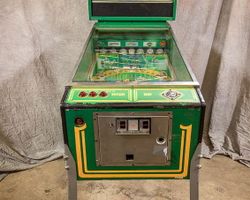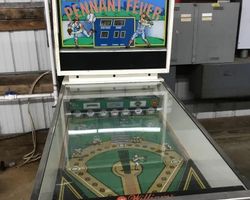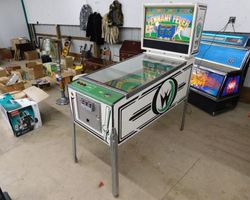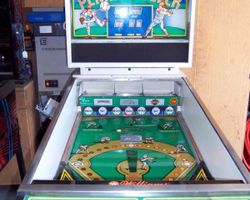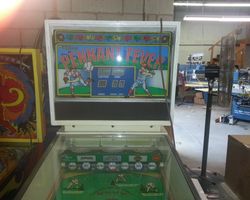Pennant Fever
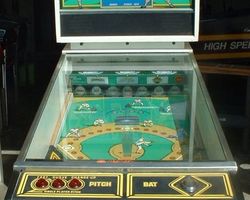
Average Prices: USD $300 to $1,000
Produced: May, 1984
Machine Type: Solid State Electronic
MPU: Williams System 8
Players: 2
Design by: Mark Ritchie
Pennant Fever, a distinctive pinball machine from Williams Electronic Games, Inc., rolled out in May 1984, representing a pivotal moment in the evolution of sports-themed amusement devices. This machine marked Williams' first foray into solid-state electronic "pitch & bat" baseball games, moving beyond the electro-mechanical predecessors that defined the genre for decades. With a limited production run of approximately 750 units, Pennant Fever stands as a specialized entry in the vast Williams pinball catalog.
The machine's creation involved a dedicated team. Mark Ritchie, known for his design contributions to numerous pinball titles, conceived the gameplay. The playfield and cabinet artwork were brought to life by Pam Erickson, while Dave Rzepka handled the software development that drove the machine's intricate baseball simulation. Larry DeMar was responsible for the speech processing, a feature that added depth and immersion to the game with umpire calls and crowd sounds. Pennant Fever utilized the Williams System 8 MPU, a robust platform for its era, which powered its digital display and solid-state mechanics. Early prototypes of Pennant Fever, identifiable by unique green cabinets and distinct serial numbers, suggest a careful development process before its widespread release.
Signature Features and Design
Pennant Fever distinguishes itself through a radical departure from traditional pinball design. Instead of conventional flippers on a standard playfield, the machine centers on a single, powerful batting mechanism. This allows players to physically "bat" a pitched pinball, sending it airborne towards various scoring opportunities. This central mechanic defines the entire experience, transforming the game from a pinball endeavor into an interactive baseball simulation.
The playfield features seven hanging targets, strategically placed to represent different hit outcomes. Complementing these targets is a wide, unpainted metal ramp, a crucial element for achieving high scores. Hitting the ball with precision and power to launch it up this ramp triggers the ultimate reward: a home run. Beyond the core batting action, the playfield integrates lights that visually track the progress of runners around the bases, adding a dynamic layer of baseball realism. The custom-shaped cabinet, while visually basic, provided the necessary form factor for this unique gameplay, housing the innovative pitching and batting mechanisms. The automatic plunger ensures consistent ball delivery to the pitcher's mound, ready for the next at-bat.
Playfield and Mechanics
The playfield layout of Pennant Fever is purpose-built for its baseball theme, diverging significantly from typical pinball machine designs. There are no traditional holes, rollovers, or complex ramp networks found in most pinball titles. Instead, the focus is squarely on the interaction between the pitched ball and the player-controlled bat. The upper part of the playfield serves as the "outfield" or "bleachers," where the hanging targets are positioned. Successfully hitting these targets with the batted ball registers base hits, advancing runners around the illuminated bases displayed on the playfield.
The large, unpainted metal ramp dominates a portion of the upper playfield. This ramp is the gateway to scoring home runs, requiring a perfectly timed and powerful hit to send the ball soaring into the upper decks. The design philosophy behind this layout emphasizes direct action and immediate feedback, mirroring the simplicity and excitement of a baseball game. The artwork, while functional and clearly depicting a baseball stadium, leans towards a more utilitarian aesthetic, with the general color palette of the machine being described as "basic and green." This aesthetic choice, along with the distinct auditory elements such as umpire calls, the roar of the crowd for big hits, and snippets of "Take Me Out to the Ball Game," collectively creates an immersive baseball atmosphere, despite its visual simplicity.
Gameplay Dynamics
Pennant Fever's gameplay dynamics are structured around the core elements of baseball. The game defaults to a three-inning structure, though this is adjustable, allowing for shorter or longer play sessions. The primary objective is to score runs by hitting the pitched ball effectively. The challenge is enhanced by the pitcher, who delivers one of three randomized pitches in single-player mode, forcing players to anticipate and react. Players have a single swing to make contact, and the ball must travel to the top of the playfield to avoid a strike.
Scoring progresses much like a real baseball game: hitting specific targets or zones advances players around the bases. The ultimate scoring opportunity comes from hitting a home run, typically achieved by connecting with a fastball and driving the ball up the metal ramp. This direct cause-and-effect loop—pitch, swing, hit, and run advancement—makes the gameplay highly intuitive and immediately gratifying. The game truly shines in its simultaneous two-player mode, where friends or family can compete head-to-head, adding a social competitive layer that enhances the overall experience. The clear objectives and straightforward mechanics mean there are no convoluted rules or hidden secrets to decipher, allowing players to jump straight into the action and enjoy the simple pleasure of hitting a pinball.
Reception and Legacy
Pennant Fever garnered a largely positive reception, particularly for its unique and accessible gameplay. Players frequently describe it as a "fun and enjoyable machine," a sentiment often attributed to its straightforward "plain ole hit the ball and score" mechanic. Its simplicity is often highlighted as a strength, making it highly accessible for casual players and an appealing option for social gatherings. Many consider it "the life of the party," providing "quick and easy fun" that doesn't require extensive knowledge of complex pinball rules. Its slow, deliberate gameplay is seen as fitting for the baseball theme, contributing to a relaxed yet engaging experience.
However, the machine also faced criticisms, primarily regarding its aesthetics. Described by some as "rather ugly," "lacking style," or "very basic and green," its visual presentation sometimes fell short when compared to the more elaborate designs of other pinball machines, including older electro-mechanical pitch and bat games. While the artwork and sound were considered acceptable for their time, they were not viewed as outstanding, and the lighting effects were often deemed less impressive than those on earlier games. From a maintenance perspective, the use of the System 8 board set presented challenges, as getting the machine running could be difficult, and spare parts, especially the MPU, became exceptionally hard to source, posing a significant hurdle for collectors.
Despite these drawbacks, Pennant Fever holds a notable place in pinball history. It represents Williams' pioneering effort in solid-state "pitch & bat" technology, laying groundwork for future innovations in specialized pinball sub-genres. Its distinct gameplay, setting it apart from traditional flipper-based machines, ensures its continued relevance as a unique addition to any collection. The machine’s enduring appeal lies in its ability to deliver pure, unadulterated enjoyment, demonstrating that sometimes, the most basic concepts, executed well, can provide the most memorable experiences.
Sponsored Links
 Ebay Listings
Ebay Listings
 Auction Results
Auction Results
| Cost | Location | Date |
|---|---|---|
| USD $3,195 |  Washington, United States Washington, United States |
06 April, 2022 |
| USD $210 |  Maryland, United States Maryland, United States |
14 May, 2021 |
| USD $1,100 |  California, United States California, United States |
23 March, 2021 |
| USD $510 |  Maryland, United States Maryland, United States |
13 November, 2020 |
| USD $1,195 |  Ohio, United States Ohio, United States |
27 December, 2019 |
| USD $1,100 |  Ohio, United States Ohio, United States |
02 January, 2019 |
| USD $450 |  New Jersey, United States New Jersey, United States |
09 June, 2018 |
| USD $1,000 |  Texas, United States Texas, United States |
14 January, 2017 |
| USD $1,000 |  Georgia, United States Georgia, United States |
11 January, 2017 |
| USD $1,400 |  Connecticut, United States Connecticut, United States |
11 December, 2015 |


Private Policy · Search Website · Contact Us
As an eBay Partner, we may earn a commission from qualifying purchases made through links on this site, at no additional cost to you.
All trademarks and copyrighted materials remain property of their respective owners. All other content copyright 2007 - 2025 Pinpedia.

